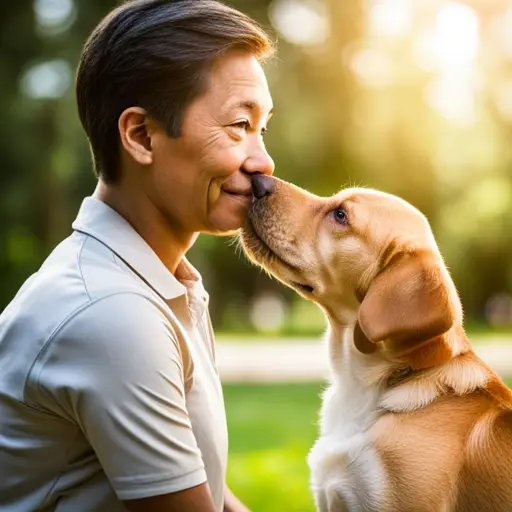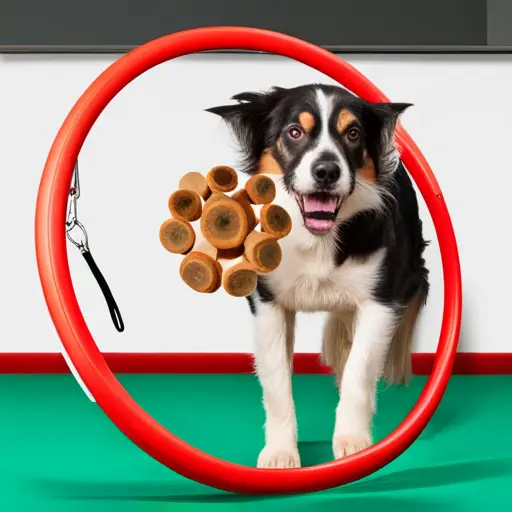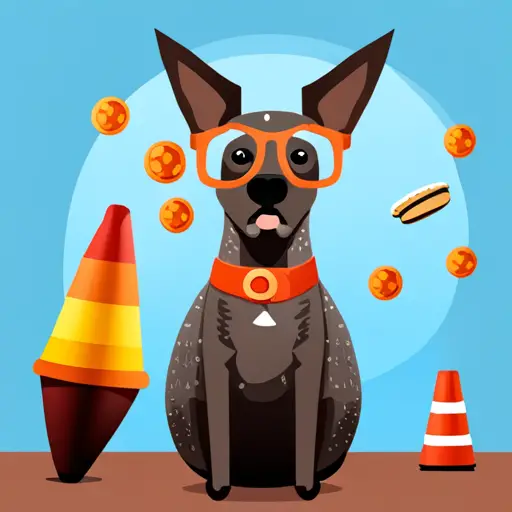Do you want your furry friend to be the most well-behaved dog in town? Obedience training is the key to taking your dog’s training to the next level.
Whether you have a new puppy or an older dog, obedience training can help improve their behavior and strengthen your bond with them.
Obedience training is more than just teaching your dog basic commands like sit and stay. It’s about building a relationship based on trust and respect.
In this article, we’ll cover the basics of obedience training, how to incorporate advanced techniques, and how to use obedience training to address problem behaviors.
You can maintain obedience training for long-term success with the right techniques and consistency. So let’s get started and take your dog’s training to the next level!
Key Takeaways
- Obedience training improves behavior and strengthens the bond between dog and owner while providing mental stimulation and physical abilities.
- Essential commands to teach include sit, stay, come, and heel, and positive reinforcement is important, while physical punishment should be avoided.
- Consistency and practice are key to long-term success, and gradually increasing difficulty and adding distractions while using different environments for generalization can also lead to successful training.
- Problematic behaviors such as anger and excessive barking, destructive chewing, jumping, separation anxiety, and barking can all be addressed through training by identifying the cause and using positive reinforcement techniques.
Understand the Basics of Obedience Training

If you’re serious about taking your dog’s training to the next level, you gotta understand the basics of obedience training. The training methods used in obedience training are designed to teach your dog how to behave appropriately in different situations. This type of training isn’t only beneficial for your dog and can also improve your relationship with your furry friend.
The benefits of obedience training are numerous. It can help your dog become more confident, well-behaved, and socialized. Your dog will learn basic commands such as sit, stay, and come, which are essential for a well-trained dog.
Additionally, obedience training can help reduce unwanted behaviors such as jumping, barking, and digging. You’ll have a happier, healthier, and more obedient dog with obedience training.
Now, let’s move on to the next section and learn how to teach your dog basic commands.
Teach Basic Commands

Now that you’ve got a basic understanding of obedience training let’s focus on teaching your dog some essential commands. Your dog needs to learn to sit, stay, come, and heel.
By teaching your pet these commands, you can create a strong foundation for their training and improve communication with them. So let’s dive into each command and learn the best ways to teach them to your furry friend.
Sit
During sit training, your dog will learn to associate the command with the action, resulting in a 95% success rate of sitting on command. This basic command is essential for teaching your dog obedience and respect. During the training process, correcting mistakes and reinforcing positive behavior is important to achieve success.
Use a reward system such as treats or verbal praise to reinforce positive behavior during sit training. Correct mistakes by calmly repeating the command and gently guiding your dog to sit. It is important to avoid physical punishment as this can lead to fear and aggression in your dog.
In addition, a helpful tool during sit training is a table that shows the benefits and steps to mastering the command. This table can be used as a quick reference guide during training sessions. As you master the sit command, you can progress to the next step of obedience training: stay.
Stay
To master the stay command, your pup must be patient and focused, remaining in place until permitted to move. Start by practicing in a quiet area with minimal distractions.
Ask your dog to sit, then give the command ‘stay’ while holding your hand out in front of them. Step back, immediately return to your dog’s side and reward them with a treat and praise if they remain in place.
Gradually increase the duration of the stay, taking a step back each time and rewarding your pup for their patience.
Once your pup has mastered staying in place longer, it’s time to add distractions. Start with simple distractions like a toy or another person in the room, then work up to more challenging distractions like a loud noise or other dogs. Remember to start small and gradually increase the difficulty level.
With consistent practice, your pup will learn to stay focused on you and remain in place until permitted to move.
Now that you’ve mastered the stay command, it’s time to move on to the next step: teaching your pup to come when called.
Come
Teaching your pup to come when called is essential for their safety and your peace of mind. You never know when they might wander off or get into trouble. Start by teaching obedience to puppies as early as possible, making it a fun and positive experience.
One common mistake in obedience training is to punish your dog for not coming when called. This can make them fearful and reluctant to obey. Instead, use positive reinforcement, such as treats and affection, to encourage them to come to you when called.
To reinforce this behavior, practice calling your dog to come to you frequently throughout the day. Start in a quiet and familiar place, gradually increasing distraction and difficulty. Eventually, your dog will learn to come to you no matter where or what they are doing. This will not only improve their safety but will also strengthen your bond with them.
Now that your pup has mastered the ‘come’ command, it’s time to move on to the next obedience training: ‘heel.’ This command teaches your dog to walk calmly and obediently by your side without pulling or getting distracted.
Heel
You’ve mastered the art of calling your dog to come to you, and now it’s time to tackle the next level of obedience training: heel.
Walking your dog on a leash is more than just a simple stroll around the block. It’s an opportunity to improve your dog’s behavior and create a stronger bond between you.
Heel is a technique where your dog walks beside you on a loose leash without pulling. This technique requires patience, consistency, and a reward system to reinforce good behavior.
Use treats, toys, or praise to reward your dog when they’re walking correctly by your side. With time and practice, your dog will become familiar with the expectations of walking on a loose leash, and you won’t need to rely on rewards as much.
As you continue to hone your dog’s obedience training, it’s important to incorporate advanced training techniques to keep them engaged and progressing. But before we dive into those techniques, let’s first focus on perfecting your dog’s heel technique.
Incorporate Advanced Training Techniques

Regarding obedience training, stepping up your game with advanced techniques will impress others and strengthen your bond with your furry companion.
Advanced tricks and agility training are two key subtopics to explore in your quest for more advanced training. Advanced tricks involve teaching your dog complex behaviors such as jumping through hoops, playing dead, or even fetching specific items. These tricks challenge your dog’s intelligence and provide mental stimulation.
Agility training, on the other hand, involves setting up obstacle courses that your dog must navigate through as quickly and accurately as possible. This type of training improves your dog’s physical abilities and ability to follow commands and think on their feet.
By incorporating these advanced techniques into your dog’s training regimen, you can take their obedience to the next level and create a strong bond with them. As you continue to train, you’ll notice your dog becoming more confident and responsive to your commands.
In the subsequent section, we’ll explore how obedience training can also be used to address problem behaviors.
Use Obedience Training to Address Problem Behaviors

If your dog is chewing everything in sight or destroying your belongings, you can use obedience training to address these destructive behaviors.
Jumping on people can be a nuisance and even dangerous, but with obedience training, you can teach your dog to greet people politely.
Excessive barking and vocalization can also be addressed through obedience training, helping your dog learn to communicate appropriately.
Chewing and Destructive Behaviors
Dogs are natural chewers, and according to a study by the American Veterinary Medical Association, destructive chewing is the third most common reason dogs are surrendered to shelters. However, there are ways to prevent this behavior from becoming a problem and redirect it when it does occur.
Here are some prevention techniques and ways to redirect behavior:
- Provide plenty of appropriate chew toys.
- Supervise your dog when they’re not in a crate or confined area.
- Use bitter apple spray or other deterrents on items your dog likes to chew.
- Keep items your dog may find tempting out of reach.
If your dog does chew something they shouldn’t, it’s important to redirect their behavior to an appropriate chew toy. Encourage your dog to chew on the toy instead and praise them when they do so. By providing your dog with appropriate chew toys and redirecting their chewing behavior, you can help prevent destructive chewing and keep your belongings safe.
When jumping on people, there are also effective techniques for addressing this behavior.
Jumping on People
Jumping on people can be frustrating for you and your furry friend, but there are ways to address it. Preventing jumping behavior starts with understanding why your dog is doing it. Dogs jump to greet people because they’re excited to see them and want to show their love and affection. However, this behavior can be dangerous, especially if your dog is large and energetic.
To prevent this behavior, you can use positive reinforcement techniques. Start by teaching your dog to sit when greeting people instead of jumping. When your dog sits, reward them with treats, praise, and affection. You can also ask your guests to ignore your dog until they’re calm and sitting. With consistency and patience, your furry friend will learn that sitting is a better way to greet people than jumping.
As you work on preventing jumping behavior, you must also address barking and excessive vocalization. Dogs often bark to communicate with their owners or to express their feelings. The next section discusses training your dog to control its barking and vocalization.
Barking and Excessive Vocalization
Well, looks like your furry friend’s a master of opera singing, but if you’re tired of their excessive howling, there are ways to address it.
Training techniques for excessive barking can involve rewarding your dog for being quiet, teaching them a ‘quiet’ command, and using positive reinforcement training to redirect their attention from barking.
It’s important to identify the cause of the barking, whether it’s boredom, anxiety, or attention-seeking behavior, to effectively address the problem.
Dealing with separation anxiety in dogs can also factor in excessive vocalization. Obedience training can help by teaching your dog to stay calm and relaxed when you leave and return home.
Gradually increasing the time you’re away and providing your dog with toys and treats can help alleviate separation anxiety. By addressing barking and vocalization through training and separation anxiety, you can create a more peaceful and harmonious home environment for you and your dog.
Let’s continue our discussion on maintaining obedience training for long-term success.
Maintain Obedience Training for Long-Term Success

To ensure your furry friend’s good behavior for years, consistently reinforcing their training with positive feedback and rewards is important. This means that you should prioritize practicing obedience training with your dog regularly, even if they have already mastered the commands.
Dogs, like humans, need practice and repetition to retain information and build muscle memory. By continuing to work on their obedience training, you will reinforce their good habits and prevent any bad habits from forming.
Another way to maintain obedience training for long-term success is to train your dog outside of the home environment. Dogs can become accustomed to following commands in a specific setting, such as your living room or backyard.
However, when you take them to a new environment, they may become distracted and forget their training. Practicing obedience training in different locations will help your dog generalize their training and learn to follow commands no matter where they are. Use the table below to brainstorm new environments where you can train your dog and incorporate those locations into your training routine.
| Location | Benefits | Challenges |
|---|---|---|
| Park | Distractions, socialization opportunities | Unfamiliar smells, other dogs |
| Pet Store | Socialization opportunities, controlled environment | Distractions, other dogs |
| Beach | Exercise, new experiences | Distractions, safety concerns |
| Trail | Exercise, mental stimulation | Wildlife, safety concerns |
| Friend’s House | Socialization opportunities | Unfamiliar environment, other dogs |
You can consistently reinforce your dog’s obedience training and practice in different environments to ensure their good behavior for years. Remember always to use positive reinforcement, rewards, patience, and consistency to achieve the best results.
Conclusion
Congratulations on taking the first step toward becoming a dog obedience master! With the basics under your belt, you’re ready to take on more advanced techniques and tackle problem behaviors head-on.
But let’s be real – obedience training isn’t just about having a well-behaved pup. It’s about asserting your dominance as the alpha human in the household.
So, when your furry friend chews on your favorite shoes or bark at the mailman, don’t be afraid to show them who’s boss. And if all else fails, remember that a shock collar is always an option.
After all, nothing says ‘I love you’ like a little electric shock therapy. With these tips and tricks, your furry companion will obey your every command in no time.
Now go forth, and conquer the canine kingdom!
